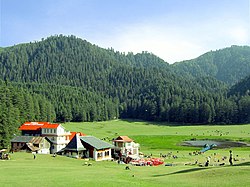Economy of Himachal Pradesh
 | |
| 1 April – 31 March | |
| Statistics | |
| GDP | ₹2.14 lakh crore (US$25 billion) (2023-24 est.)[1] |
| GDP rank | 22nd |
GDP growth | +10.2% (2020-21)[1] |
GDP per capita | ₹286,401 (US$3,300) (2023-24)[1] |
GDP by sector | Agriculture 14% Industry 40% Services 46% (2020-21)[1] |
| 2% | |
Population below poverty line | 0.23% |
| Unemployment | 1.2% (2018-19)[2] |
| Public finances | |
| 0.49% of GSDP (2022-23 est.)[1] | |
| ₹909,602 crore (US$100 billion) 4.98% of GSDP (2022-23 est.)[1] | |
| Revenues | ₹9,036,420 crore (US$1.0 trillion) (2022-23 est.)[1] |
| Expenses | ₹8,046,023 crore (US$920 billion) (2022-23 est.)[1] |
The era of economic planning started in Himachal Pradesh in 1948. The first five-year plan allocated about Rs. 52.7 million to Himachal. More than 50% of this expenditure was spent on transport facilities since it was felt that without proper it, the process of planning and development couldn't be carried.
The community development programme which was launched in 1952 in Himachal, in certain selected areas was later extended to the entire rural Himachal. In Mandi and Kangra, package programmes were undertaken in collaboration with the West Germany for popularising modern techniques of cultivation among the farmers. Suitable agricultural machinery and animal husbandry were introduced in these areas. Well equipped soil testing laboratories, dairy farms and agricultural workshops were set up at various centres, besides an Agriculture University at Palampur.
Himachal is one of those states in India which was rapidly transformed from the most backward part of the country to one of the most advanced states. At present Himachal ranks fourth in respect of per capita income among the states of the Indian Union.
Himachal education system is well established, its agriculture is enough for its self-sufficiency, its horticulture is highly impressive in the country and even in abroad, its road connectivity system has emerged as the best in the mountainous areas in India, the infrastructure for its industrial development are well laid out, its rich forest resources being augmented and above all, the increasing attention of the nation towards the exploitation of its hydel resources are the signs for its bright future.[3] It has already become the ideal in respect of development for the hill areas of the country.
Agriculture[edit]
Agriculture contributes nearly about 45% to the net state domestic product. It is the main source of income as well Himachal pradesh is known as Apple state or apple capital of india Theog Rohru Kinnaur Kullu is leading supplies of the major crop grown in himachal Pradesh as employment in Himachal. About 93% of the state population depend directly upon agriculture. The main cereals grown in the state are wheat, maize, rice and barley and apples . Kangra, Mandi and Paonta valley of Sirmaur district (to some extent) are the major producers of the first three cereals, while barley is mostly cultivated in Shimla. Fruit cultivation has also proved to be an economic boon to the state. There are huge tracts of land suitable only for growing fruits. Fruit of all cultivation does not add to the problem of soil erosion and its employment potential is more than the conventional farming. The yield per acre in terms of income is also much higher. Apple produces the maximum income. Fruit growing in the state is fetching over Rs. 3 billion annually. Special efforts are being made to promote cultivation of crops like olives, figs, hops, mushrooms, flowers, pistachio nuts, sarda melon and saffron. The state has also earned the name of the Apple State of India.[4]
Industry[edit]
Ecology has been given importance in the state during the last few years. Industries becoming the cause of water or air pollution are not encouraged. Every industrial project has to be passed by the clearance of the Environment Protection Organization before its establishment. Himachal is facing a number of difficulties in the advancement of industries. Lack of means of dependable transport and poor accessibility was one of the major drawbacks. Other problems faced by the state were the poor mineral resources, non-availability of infrastructure and communication facilities, shortage of capital and lack of modern skills. The only advantage of the state was the ample availability of electricity. Parwano, Barotiwala, Baddi, Paonta Sahib, Mehatpur, Shamshi, Nagrota Bagwan, Bilaspur, Reckong Peo and Sansar Pur Terrace are some of the industrial areas of the state at present. As the dust free climate of Himachal is extremely suitable for the setting up of electronic industries, many electronic complexes have been established at Solan, Mandi, Hamirpur, Shoghi, Raga-Ka-Bagh, Chamba, Ambi, Taliwala and Keylong.[5] Moving one step further to its growth Baddi, Barotiwal & Nalagarh Industrial area have made its presence online with a domain name baddionline.com. And other Industrial Areas of Himachal Pradesh will be covered soon.[6]
| Gross State Domestic Product at Current Prices
figures in crores of Indian Rupees | |
| Year | Gross State Domestic Product |
|---|---|
| 1980 | 7,940 |
| 1985 | 13,720 |
| 1990 | 28,150 |
| 1995 | 66,980 |
| 2000 | 135,900 |
References[edit]
- ↑ 1.0 1.1 1.2 1.3 1.4 1.5 1.6 1.7 "Himachal Pradesh Budget Analysis 2022-23". PRS Legislative Research. Retrieved 12 March 2022.
- ↑ "Himachal Pradesh Budget Analysis 2021-22". PRS Legislative Research. Retrieved 12 March 2022.
- ↑ Economy of Himachal @ webindia123
- ↑ Economy of Himachal by Agriculture @ webindia123.com Suni System (P) Ltd. Retrieved on- 2007-06-27
- ↑ Industry @Webindia123.com Suni system (P) Ltd. Retrieved on- 2007-06-27
- ↑ Baddi, Barotiwala Nalagarh Business Directory